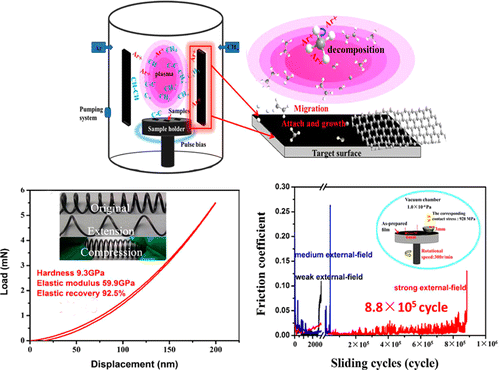Abstract: A special catalytic growth effect (called the "external-field induced effect") was found to exist on the poisoning target surface during the reactive sputtering process of a-C:H films. Enlightened by this effect, we demonstrate a facile approach to manipulate the medium-range-ordered nanostructure and mechanical and tribological properties of a-C:H films. By adjusting the plasma ionization degree, a graphene precursor was successfully produced at the graphite target surface through the synergistic catalytic effects of both the catalyst and plasma. Then, graphene was further sputtered into amorphous carbon films to form graphene-like nanoclusters. This special graphene-like nanostructure endows the a-C:H film with Outstanding hardness, high, elasticity, and excellent tribological properties. The elastic recovery of the film was improved to 92.5%, and the wear life in a vacuum environment was also prolonged to 8.8 x 105 cycles at a contact stress of 0:9 GPa, which suggests that medium-range-ordered clusters in an amorphous carbon matrix provide an important way to improve the properties of carbon films.

KeyWords Plus: CARBON-FILMS; THIN-FILMS; SURFACE-ROUGHNESS; GRAPHENE FILMS; VACUUM; NANOTUBES; MECHANISM; COATINGS; LIQUIDS
Published in ACS APPLIED MATERIALS & INTERFACES, 8 (10):6639-6645; 10.1021/acsami.5b11970 MAR 16 2016


